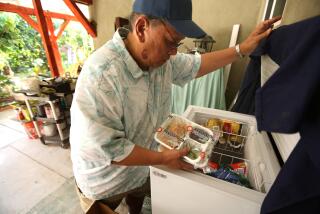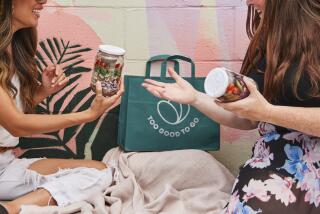Leftovers for the needy: It’s not that hard
It never ceases to amaze me how difficult it can be to get some businesses to do the right thing. Donating leftover food is a good example.
More than 14 million Americans were out of work as of last month. The national unemployment rate is 9.3%; California’s jobless rate is a staggering 12.3%. Fedmeister Ben Bernanke said last week that high unemployment is keeping the economic outlook “unusually uncertain.”
Yet as families everywhere struggle to get by, officials and businesses are still dithering over how to get unwanted food to shelters, food pantries and other resources for the down and out.
As I reported more than a year ago, California caterers, hotels and restaurants throw out roughly 1.5 million tons of perfectly good food every year, according to the state Integrated Waste Management Board.
This isn’t the still-edible food that many stores routinely donate to community groups once expiration dates are passed. No, we’re talking whole meals — the stuff in the steam trays at banquets and other functions — that frequently end up in the dumpster because no one tried to get them to those who might want or need it.
“Feeding people who are going hungry has always been a pressing issue,” said Los Angeles City Councilman Jose Huizar. “But now it’s not just homeless people we’re talking about. It’s families. It’s children.”
The L.A. City Council last week approved Huizar’s proposal that all city departments adopt policies facilitating donation of leftover food from public programs and events to organizations that feed the hungry.
“I’m looking at the City of Los Angeles to be an example to others,” he told me. “Donating surplus food should be as common as recycling. It should be part of our everyday lives.”
It should. And such altruism can’t be confined solely to the public sector. The real trick is getting businesses to also play ball.
Unfortunately, California’s restaurant industry has come out with guns blazing any time a lawmaker has had the temerity to suggest that maybe we should require businesses to donate leftover food to those who need it.
“There’s a big concern among some restaurants about the legal liability,” said Daniel Conway, a spokesman for the California Restaurant Assn. “There’s a real feeling that one lawsuit could wipe a restaurant out.”
The fear, of course, is that donated food could go bad and make people sick. But there’s an answer to that.
A federal law, the Emerson Good Samaritan Food Donation Act, was passed in 1996. It shields individuals and organizations from civil and criminal liability when food is donated to a nonprofit group.
To run afoul of the law, a donor would have to commit an act of “gross negligence,” defined as “voluntary and conscious conduct” that is “likely to be harmful to the health or well-being of another person.”
Conway said that legal concerns aside, the bigger worry for restaurants and other food businesses is logistics.
“We just don’t know how you would get all this food to the groups that want it,” he said.
It’s a fair point. Here’s my suggestion: Let’s pass a law that requires restaurants and other food businesses to notify clients that leftover food can be donated to nonprofit organizations rather than be thrown out.
If the client approves (and who wouldn’t?) the business would then post what’s up for grabs, and the time and place it’s available, on a state-run website — a Craigslist for cuisine.
Nonprofit groups that have registered with the program would monitor the site. If they have the capability to safely pick up, transport and store the food, they’d lay claim to the goodies. First come, first served.
State Sen. Jenny Oropeza (D-Long Beach) introduced legislation in 2008 that would have imposed the modest requirement that caterers simply inform clients they have the option of donating uneaten food to charity.
That bill was shot down by the restaurant association, which argued that such a requirement would be too troublesome for its members.
Oropeza has a new bill, SB 1269, that would leave restaurants alone. It would merely require the state Department of Food and Agriculture and the Department of Public Health to post information on their respective websites reminding potential donors about the federal Good Samaritan law.
That’s not good enough. I asked Conway at the restaurant association what he thought of the idea of an online exchange for leftovers. He said he’d have to see the details of such a plan, but it’s not something he’d dismiss out of hand.
“That’s certainly something we would discuss,” Conway said.
I would imagine that if donors and recipients could routinely meet online, new nonprofits would emerge specializing in getting food from Point A to Point B.
The Rev. Andy Bales, chief executive of Union Rescue Mission in the skid row section of downtown L.A., said organizations like his would welcome any measure that would boost the amount of food available to the hungry.
As it stands, the rescue mission serves as many as 4,900 meals a day. And it’s not enough.
“We’re seeing more families, more children,” Bales said. “It would certainly help alleviate poverty if there was a better way to share leftover food.”
There is. And there’s nothing stopping us from trying.
David Lazarus’ column runs Tuesdays and Fridays. He also can be seen daily on KTLA-TV Channel 5. Send your tips or feedback to [email protected]
More to Read
Sign up for Essential California
The most important California stories and recommendations in your inbox every morning.
You may occasionally receive promotional content from the Los Angeles Times.











